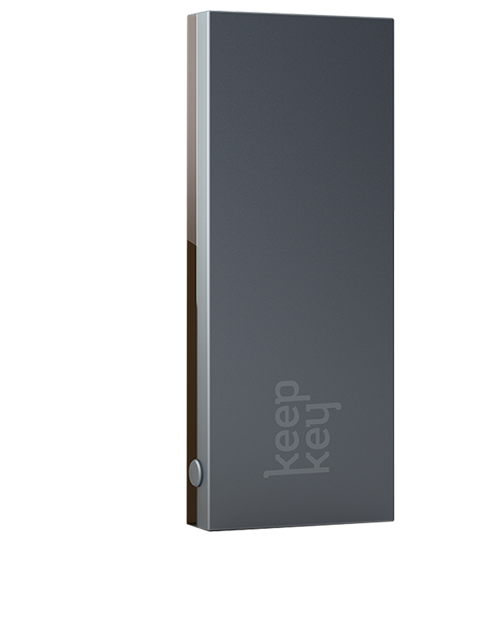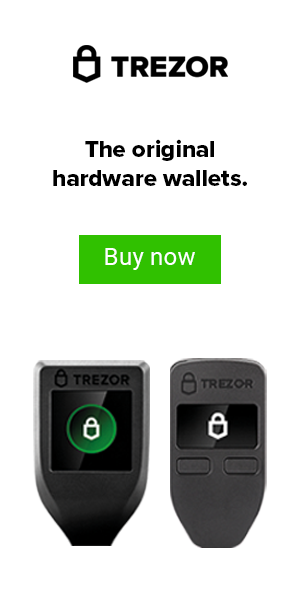You Might also like
-
KeepKey Just Released A MASSIVE Upgrade (2021)
Post Views: 0 -
[NEW] nGRAVE ZERO – 3-Tiered Crypto Hardware Wallet | FIRST LOOK (2020)
What’s going on guys Crypto Renegade here again with another video for you and in today’s video, I have found another brand new hardware wallet that is coming to us that is not on a lot of people’s radar. So stay tuned, we are doing another first look, hardware wallet review video, I’ll give you my views and my takes and what makes us different from other hardware wallets that are currently on the market or even ones that are even upcoming.
Let’s check out This Ngrave Zero First Look!
So make sure you stay tuned for that before we jump into this wallet, I want to say that I do have a free ebook download that is very in depth called the top five ways to secure your cryptocurrency you can find it on my website BitcoinLockup.com. It’s a giant orange button to download it in the top right corner, you can’t miss it. So go ahead and check it out. It’s completely free. But just wanted to mention that before we jump into the content here.
So in today’s video, we’re going to be looking at what’s called the Ngrave Zero. Now this is a brand new hardware wallet, it doesn’t have a price yet it says on the website. As you can see here, it says pre order now. But when you actually click it, it’s just on the super early early bird waitlist. So there’s no actual way to place an actual pre order, and there’s no way to find out what they’re actually going to be charging.
But I’ll give you my views as we go through it of what I think they’re going to be charging and kind of what makes this unique and a little bit different. What I’ve really liked lately is that with hardware wallets that are coming out these days are really starting to differentiate if new security details and security features and different ways of implementing the protection of your private keys, which is really interesting to me.
How Does Ngrave Zero Compare To Other Hardware Wallets?
Because back when this all started in the first hardware wallet, the Trezor came out, you know, there wasn’t that many differences between, you know, a Ledger, Trezor, or a KeepKey in terms of the functionality in terms of the security and in terms of the design. But we’re really coming into new territory here where we’re coming into a new wave of technology, and security for these hardware wallets.
So really, really exciting here stuff further ado, let’s go ahead and get started here. So this one is a as you can see in the form factor, it’s a kind of a small touchscreen tablet here. It’s 100% offline. So this is a three tiered system, which I’ll go into in just a second. But basically, this is an all in one solution for a hardware wallet.
I know that on my channel, I go into different solutions in terms of protecting your private keys. One being a hardware wallet, another being a metal recovery seed backup, to protect your recovery seed, if you ever lose your hardware wallet, that you have a safe way to implement it and restore your funds and restore your private keys.
And then there’s also software wallets, which is sort of like having a wallet in your back pocket with Fiat, which is typically used for day to day transactions. And it’s not meant for long term storage, it’s not meant for savings or anything like that.
You keep that on a software wallet that you will ultimately spend on a day to day basis, maybe a couple hundred dollars or whatever is comfortable for you. But in this case, they’ve kind of implemented an all in one solution, which is really, really nice. I haven’t seen that yet on any hardware wallets, you know, people like Trezor and Ledger, they sell bundle packs with metal recovery seed backup solutions that they can go ahead and bundle and sell it with. But in this they’re coming with an all in one solution. So I assume it’s going to be priced appropriately.
So with this Ngrave Zero here, they’re calling it the coldest wallet, okay. And there’s a reason that they’re that they’re touting that and that it’s going to be, you know, considered the coldest versus any other type of hardware wallet here. So this is a QR code based device, meaning there is going to be an app integrated with it. And I’ll get into that in just a second.
How Secure Is Ngrave Zero?
But there’s an app here, similar to the functionality of the Cobo Vault, similar to the functionality of the Ellipal Titan, and things like that, where you utilize the device to take pictures, and authorize transactions by scanning the QR codes and signing them. So it’s completely offline no Bluetooth, no USB, no cellular no Wi Fi, no other connection is completely off the grid, which is extremely nice. On this, it’s going to give you the three all in one solution wallet that I was talking about here.
I mean, it looks like it’s gonna have a decent sized touchscreen, which again, I’ve gone over in other videos and mentioned how important it is when you’re dealing with hardware wallets on a regular basis. Having a larger screen to scan QR codes to navigate to us is extremely helpful and very user friendly. Not to mention, it’s safer because it displays the Full Wallet address for you to confirm.
When you’re dealing with ledger, ledger devices or sometimes even Trezor devices, you’re going to see that it’s hard to read and verify the wallet address before you authorize and sign the transaction. So you know, again, having a larger screen makes a huge night and day difference in terms of security as well as functionality.
So what they’ve come up with here is a different kind of metal recovery seed backup. It’s complete, accidental decimal system here where it’s basically two parts. As you can see in the screen here, it has sort of a template that you overlay on top of the sheet here. And you basically line up your recovery seed phrase with the first four letters and is translated into numbers.
Okay, so what’s really, really interesting with this here is that you have the plate that where you can use the tool to puncture holes, and then you have the actual plate behind it, that’s embedded as well. And you keep these separate, because you can’t use one without the other. As you can see, the other one just has random holes placed all over it, as you can see in the background. And then there’s this sheet that goes over it, that’s the template.
What Is included in the Ngrave Zero Three-Tiered Crypto Solution?
That’s where you actually engrave your recovery seed phrase. So this gives you an extra layer of security, you basically keep the template in one location, you keep the actual metal plate location, and they only work when you put them together.
So you obviously need the template to line up the letters and line up the numbers so that you can decode your private key something that is somewhat similar to the CryptoTag Zeus, in effect that you know, you have to puncture different letters and numbers to sort of decode it. But this is the first solution where it actually overlays in a requires two pieces of the puzzle to actually make it work period.
So that’s really interesting to me. And I think it’s a really innovative approach here. So the engrave zero, that’s what they’re calling the actual physical hardware wallet device that you see here.
It comes with a state of the art security chips, true random number generator, anti tampering, it’s basically a very secure device. And ultimately, it’s it’s built in a way where it’s very hard to disassemble, and going through and trying to extract any sort of private keys, the metal solution that we just talked about is called the Ngrave Graphene or Metal recovery seed backup that we talked about made out of stainless steel plates.
You can use that to restore your private key if the hardware wallet device is ever compromised, lost, stolen, anything like that. And it’s designed, as I mentioned, to hold the template, or the sheet where here where you actually engrave it, and then the actual metal sheet in two different locations for added security.
The third solution here in this the three tier solution is the Ngrave Liquid. This is again, this is the mobile app where you actually manage sign the QR codes manage balances. Again, this is similar in effect to the Ellipal Titan, but this is where you’ll manage all your funds, your portfolio, your transactions, this is where you’ll sign on the device on the hardware wallet device itself and vice versa, to be able to send and receive transactions we just sent.
You know just signing the transactions when you do it, you can obviously receive on any QR code that you want. So you know, this is an interesting three tier system. That’s all in one, you know, I’ve always wondered why all these companies are so different. And we need all of these different solutions. You know, it’s sort of fragmented, and we need all these different solutions to really be secure.
So this is really the first company that I’ve seen that is offering a full all in one solution for metal recovery seed backup, having a mobile app dedicated for it, as well as a hardware wallet device, you know, you’ll see sometimes two out of three, but never three out of three, like I’m seeing here. So this is extremely interesting. The Ngrave Zero device itself has a really nice camera. As you can see the form factor looks different and interesting bar.
As I mentioned before, there’s no USBs there’s no networks, it’s completely air gapped. Similar to those other devices. It has the one way QR code communication, which is the safest way to do it. And then offline defenses. Again, this is where the graphene and the metal recovery seed come in.
And just sort of having those different layers of security make it not only easier to use but also more secure for you and your private keys when you’re in possession of them. So this also boasts the most advanced key generation process in the world you know, they have a state-of-the-art TRNG or true random number generator chip allows you to make sure that your private keys are generated in a secure manner.
This also does have a fingerprint sensor. So there is biometric data. This is now the third biometric hardware wallet that I’ve seen today only one of which has made it to market and that’s called the D’CENT Wallet. And if you’re interested in that, I’ll link that down below with a very special discount in partnership with my website Bitcoin in lockup calm, it also has light technology implemented.
So there’s different photon measurements of ambient light that are one of the best enhancers of randomness and strength of your secret key, which is really interesting. Haven’t heard of that before. And then the interaction here, like I mentioned, again, not to beat it with a dead horse, but it is completely offline, which in my opinion, is the most secure way to do it instead of a USB Bluetooth things like that.
You’re going to see what other different hardware wallets you know, I don’t have a referral code or anything for this because there’s just so new, you can come to the website and grave.io and that will actually allow you to join the early bird list and get the best discounts you know if this is something that you’re interested in, as far as the coin support and as far as the actual price of the device, I’m only speculating at this point, they do give a how we compare kind of white paper that goes over the different comparisons between Ledger, Trezor, KeepKey, that kind of a thing.
But I wanted to say here that as far as the price of this device, because it’s an all in one solution, my best guess is this is going to be anywhere between, I would say $250 and $350. us, which is probably pretty fair for the for the amount of security and the amount of quality that you’re getting for all of these solutions built into one. So this is extremely interesting. If that is going to be the price point.
Again, I have no basis for that. I’m just guessing based on the current market right now and similar and comparable products, to kind of give you an idea of what this could cause in terms of the coins support.
They haven’t announced anything almost guarantee you that you’re going to have obviously all of your basic coins are going to have all your ERC 20 tokens, your top market cap coins, your Bitcoin, your Ethereum, your Litecoin, your Bitcoin Cash, your Stellar things of that nature. So ultimately, I don’t have a full point this I will come and do another follow up video once we get more information on this. But I’m assuming it’s going to have all your basic coins, you know, hundreds, if not thousands of ERC 20 tokens, and we’ll see if there’s any unique coins that are going to be supported by this device as time goes on.
Ngrave Zero: Conclusion
So I’m really excited to see how this turns out. Again, this is a really interesting all in one solution. And I’m going to be keeping my eye out on it and be reaching out to the founders to see if I can get a demo of the device and do an unboxing video for you.
I’m gonna go ahead and wrap that up here. If you found any value or you found this interesting in any way, please go ahead and subscribe and leave a comment down below. If you’ve come across or even heard of this hardware wall. Go ahead and comment and let me know where do you found it. I’m very interested to hear about that. I mean I dig and find these things on a regular basis.
So if you’ve already heard about it, you know through a press release or through media or anything like that I’d be interested to hear and then again, if you’re brand new to the channel, I would appreciate if you subscribe if you do like hardware wallet videos, protecting your private keys, ways to earn free Bitcoin and to just implement yourself in a really solid foundation into the crypto ecosystem. I do believe it’s the future, then go ahead and subscribe. I’m going to go ahead and wrap this up here.
What do you think? Is this a hardware wallet you would buy when its available? Let me know in the comments below!
Cheers,
The Crypto Renegade
NOTE: This post may contain affiliate links. This adds no cost to you but it helps me focus on giving as much value as possible in every single post by being compensated for recommending products that help people succeed.
Post Views: 0














